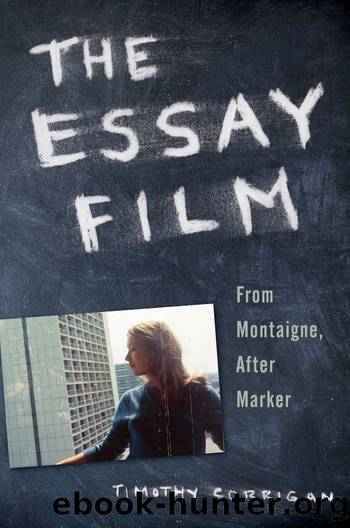Essay Film by Corrigan Timothy;

Author:Corrigan, Timothy;
Language: eng
Format: epub
Publisher: Oxford University Press, USA
Published: 2011-09-14T16:00:00+00:00
FIGURE 4.8 Walking the mazes of grizzly bear territory (Grizzly Man)
The fantastically primitive dreams of foot travel, the ecstatic truths of these essay films describe consistently the radical diminution of a self within the experience of a world so massively indifferent that it becomes, by default, a concomitantly horrifying and casual dismissal of the human desire for sense and selfhood, a dismissal and a desire that in their collision leave behind only the material detritus, artifacts, and scars of thought as physical testimonies to the mostly bathetic claims of human intelligence and self-knowledge.
This is where I agree with Deleuze’s claim that Herzog is “the most metaphysical of cinema directors,” at least if we understand metaphysics as that realm where visions become ideas and experience generates thoughts. For Deleuze, “In Herzog we witness an extraordinary effort to present to the view specifically tactile images which characterize the situation of ‘defenceless’ beings, and unite with the grand visions of those suffering from hallucinations” ( Cinema 2 12). The continual compositional showdown between the very large and the very small in Herzog’s essay films concretizes the showdown between the physically opaque and the theatrics of desire as the figuration of limits. “As Ideas, the Small and the Large designate both two forms and two conceptions,” according to Deleuze. “These are distinct but capable of passing into one another. They have yet a third sense and designate Visions which deserve even more to be called Ideas” ( Cinema 1 184–185). For Herzog, in short, visions are hardly about transcendence but rather about that experiential convulsion in which the human engages inhuman geography and releases a sometimes sensual, sometimes comical, and sometimes ferocious idea. If in Herzog’s essay films the visionary becomes an ordinary walk through extraordinary spaces, thinking becomes an active, gymnastic, athletic encounter with a world that refuses to accommodate it.
In both its literary and cinematic practices, the essayistic voice is, as we have said, frequently the central measure of a subjective movement through experience: authorial persona or audio voice-overs describe, comment on, question, reflect on, and often subject themselves to the visual and intellectual relation between an observing eye and the world and spaces it sees and experiences. Perhaps partly because of the visual eccentricities and splendor of Herzog’s films, the essayistic voice in his films is, I think, generally underestimated. Yet, it is a precisely structured, epistolary voice of experience whose linguistic drama infuses Herzog’s travelogues with the pressure of thinking so central to the essay film. If Herzog’s subjects typically act out the strain between the theatrics of desire and the resistant surfaces of the world, his voice becomes the supportive, mediating, and interfering intellect that, in its wonderful reticence, does not and cannot resolve that tension. While there is certainly some irony in describing films so well known for their stunning images in terms of their audio track, it is Herzog’s voice that foregrounds so importantly the energy of thought left along the road of a theatrically experienced world.10
Language and voice have been a preoccupation in virtually all of Herzog’s films.
Download
This site does not store any files on its server. We only index and link to content provided by other sites. Please contact the content providers to delete copyright contents if any and email us, we'll remove relevant links or contents immediately.
Shoot Sexy by Ryan Armbrust(17142)
Portrait Mastery in Black & White: Learn the Signature Style of a Legendary Photographer by Tim Kelly(16484)
Adobe Camera Raw For Digital Photographers Only by Rob Sheppard(16388)
Photographically Speaking: A Deeper Look at Creating Stronger Images (Eva Spring's Library) by David duChemin(16161)
Bombshells: Glamour Girls of a Lifetime by Sullivan Steve(13109)
Art Nude Photography Explained: How to Photograph and Understand Great Art Nude Images by Simon Walden(12348)
Perfect Rhythm by Jae(4621)
Pillow Thoughts by Courtney Peppernell(3398)
The Book of Joy by Dalai Lama(3218)
Good by S. Walden(2915)
The Pixar Touch by David A. Price(2740)
Fantastic Beasts: The Crimes of Grindelwald by J. K. Rowling(2543)
A Dictionary of Sociology by Unknown(2518)
Humans of New York by Brandon Stanton(2379)
Read This If You Want to Take Great Photographs by Carroll Henry(2303)
Stacked Decks by The Rotenberg Collection(2270)
On Photography by Susan Sontag(2131)
Photographic Guide to the Birds of Indonesia by Strange Morten;(2088)
Insomniac City by Bill Hayes(2085)
